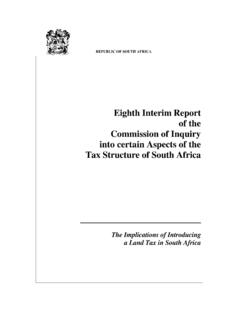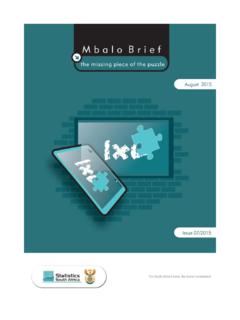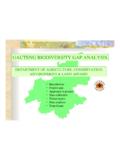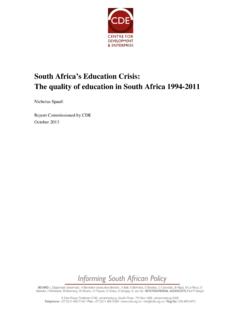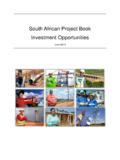Transcription of In Search Of Land and Housing in the New South Africa
1 In Search Of land and Housing in the New South Africa : The Case of Ethembalethu 2 Abstract and acknowledgements This case study analyzes the difficulties a poor community experienced in accessing peri-urban land in South Africa . A decade ago, this community, composed largely of laid-off farm workers, wanted to buy their own farm in a peri-urban area west of Johannesburg to establish a mixed-use settlement. The name of the village would be Ethembalethu Our Hope and the 250 member families started their own savings scheme to make their dream a reality. By 1997, they had saved enough money (R125,000 or about US$18,000) to make their first purchase offer. Now, a decade later, the community s dream has still not become reality, due to numerous obstacles, including two canceled sale agreements, wrongful arrest, being sued in court, an out-of-court settlement for which community members were paid R250,000 to not move into the white neighborhood, and large sums of their own money spent on consultants and environmental impact studies.
2 While the community now has at least a confirmed right to eventually occupy the land in terms of an agreement with Mogale City Municipality, it does not yet legally own the land , and is still trying to get permission to build on and work the land . Millions of black South Africans live in the peri-urban areas. However, supply driven government programs, development planning and environmental regulations, and the current land and Housing markets do not support realization of their aspirations to become home owners on sites of their choice in peri-urban areas. Based on this case study, we suggest the following areas for policy and program reform: (i) overcoming reluctance and resistance by municipalities and prospective neighbors to low-income settlements; (ii) making land use planning in municipalities explicitly pro-poor; (iii) restructuring the land market; (iv) realigning planning processes; (v) designing a land and Housing program targeted to peri-urban areas; (vi) reengineering program implementations; and (vii) freeing up and building capacity.
3 The study proposes the establishment of a national task force to ensure appropriate follow up. This study was undertaken at the request of Mogale City for World Bank technical assistance on the design and implementation of integrated Housing and agriculture projects. The team was composed of Stephen Berrisford and Michael Kihato (consultants), Zimkhitha Mhlanga (Deputy Director Rural Development, Mogale City), Ntombini Marrengane and Dave DeGroot (Urban/ Water, East and Southern Africa , Africa Region, World Bank), and Rogier van den Brink (Country Economist, Poverty Reduction and Economic Management, Southern Africa , Africa Region, World Bank). Peer Reviewers were Hans Binswanger (consultant) and Kate Kuper (Urban/Water, East and Southern Africa , Africa Region, World Bank). The responsible managers were Ritva Reinikka (Country Director), Glen Thomas (Director-General land 3 Affairs), Jaime Biderman (Urban/Water, East and Southern Africa , Africa Region, World Bank), Emmanuel Akpa (Poverty Reduction and Economic Management, Southern Africa , Africa Region, World Bank) and Frank Byamugisha (Environmentally and Socially Sustainable Development, Southern Africa , Africa Region, World Bank).
4 A draft report was jointly reviewed by the Department of land Affairs and the World Bank. Comments were received from Mzwakhe Ndlela (Director Department of land Affairs Gauteng), Vusi Radebe (Director, Housing and land , Mogale Local Municipality), George Phiri (Urban and Rural Development, Mogale City Local Municipality, Molefi Sebilo (Chairman, Muldersdrift Home Trust Foundation), Thabo Rabapane (Secretary, Muldersdrift Home Trust Foundation), Michael Worsnip (Cradle of Humankind Management Authority, Gauteng Provincial Government), Shamilla Chettiar (Cradle of Humankind Management Authority, Gauteng Provincial Government), Fredah Moatshe (Gauteng Department of Agriculture, Conservation and Environment), and Sheila Hughes (Senior Manager for Intergovernmental Relations, Department of Provincial and Local Government).)
5 The team which conducted this study would like to thank all stakeholders involved for their participation and the opportunity it accorded all of us to learn from this extraordinary story. We will continue to update the public about subsequent developments on the following website: 4 Contents List of acronyms .. 6 Executive 8 13 The geography of 13 The peri-urban areas .. 15 The case study .. 16 The story of Ethembalethu Our Hope .. 18 The vision .. 19 Not in our backyard: sued and arrested .. 19 Enter the .. 21 Bogged down in environmental impact .. 23 Key lessons 25 Overcoming reluctance and 27 Overcoming reluctance of 27 Making land use pro-poor .. 29 Revising the urban edge policy .. 29 Making the Integrated Development Plan explicitly pro-poor .. 31 Reforming the land market .. 33 Scrapping the Subdivision Act .. 33 Avoiding regressive land taxation.
6 33 Realigning planning 34 Merging township establishment and EIA processes .. 34 Simplifying township establishment 38 Designing a program for peri-urban areas .. 41 Accommodating mixed land use and multiple livelihoods .. 41 Setting affordable and appropriate standards for infrastructure and 43 Reengineering program 43 Clarifying inter-governmental roles and responsibilities .. 43 Decentralizing and unifying 46 Freeing up and building capacity .. 47 Recommendations and suggestions .. 49 54 Annexure A: Development Facilitation Act, 67 of 1995 .. 55 Principles .. 55 Development applications .. 56 Development procedures .. 57 5 FIGURES Figure 1 Apartheid spatial planning for a Figure 2 Map showing Mogale City (formerly Krugersdorp)..16 TABLES Table 1 Legislative Table 2 Timelines for various applications for township establishment: best-case 6 List of acronyms BCDA: Black Communities Development Act DFA: Development Facilitation Act DLA: Department of land Affairs DOH: Department of Housing DPLG: Department of Provincial and Local Government ECA: Environmental Conservation Act EIA: Environmental impact assessment GDOH: Gauteng Department of Housing GDACE: Gauteng Department of Agriculture, Conservation and Environment IDP: Integrated Development Plan LAA: land availability agreement LeFTEA The Less Formal Township Establishment Act LRAD: land Redistribution for Agricultural Development MEC: Member of the executive council MHTF: Muldersdrift Home Trust Foundation NDOH: National Department of Housing NEMA.
7 National Environment Management Act NGO: Non-governmental organization NIMBY Not In My Back Yard (a term used to characterize resistance by wealthy homeowners to the establishment of low-income Housing in their area) NSDP: National Spatial Development Perspective RDP: Reconstruction and Development Program SAMDI: South African Management Development Institute SLAG: Settlement and land Acquisition Grant VIP: Ventilated improved pit-latrine 7 8 Executive summary What are the difficulties the poor face in accessing peri-urban land in South Africa ? To answer this question, this case study records and analyzes the experience of a community in the Muldersdrift area of Mogale City Municipality in Gauteng: the Muldersdrift Home Trust Foundation (MHTF).
8 A decade ago, the members of this community, composed largely of laid-off farm workers, wanted to buy their own farm in a peri-urban area west of Johannesburg to establish a mixed-use settlement. The name of the village would be Ethembalethu Our Hope . Beginning with about 250 families each of which saved and contributed R50 per year, later increased to R100 per month the association aimed to acquire sufficient land in the area to build its own homes. By the end of 1997, the association was incorporated as a section 21 (not-for-profit company): the MHTF. It had saved about R125,000 and made its first purchase offer. Now, a decade later, the community s dream has still not become reality. This follows numerous obstacles, including two canceled sale agreements, wrongful arrest, being sued in court, an out-of-court settlement for which community members were paid R250,000 to not move into the white neighborhood, and large sums of their own money spent on consultants and environmental impact studies.
9 While the community now has at least a confirmed right to eventually occupy the land in terms of an agreement with Mogale City Municipality, it does not yet legally own the land , and is still trying to get permission to build on and work the land . The peri-urban areas are formerly rural localities that are now, due to the rapid expansion of South Africa s metros and major towns, directly in the path of urbanization. They lie officially outside of the urban edge . In the land market in the peri-urban areas, the rich and the poor compete directly with each other, because both prefer to live close to where they work. The preference of the rich is to live in gated Housing communities, created by the redevelopment of farms. The preference of the poor is to live in mixed-use settlements, where they can establish modest houses, raise their children in safety, benefit from having relatively close access to urban schools and health facilities, as well as work opportunities, while having space to venture into farming and small business activities should such opportunities arise.
10 Millions of black1 South Africans live in the peri-urban areas. However, even if they have the financial means to realize their aspirations, as the Ethembalethu community has, government 1 The term black in this case study refers to South Africans who are African, Indian or Colored (mixed race). 9 programs, development planning and environmental requirements, and the current land and Housing markets do not allow them realize their aspirations. The methodology followed in compiling this case study since early 2005 has been one of direct involvement with the MHTF. We have participated in project task team meetings, as well as in processes such as the negotiation of agreements between the MHTF and officials of the Mogale City Municipality. We have assisted MHTF in its efforts and provided resource materials to the various stakeholders.












